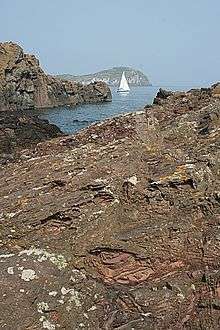Mugearite
| Igneous rock | |
 Mugearite lava flow (right); flow on left is Hawaiite | |
| Composition | |
|---|---|
| oligoclase, olivine |
Mugearite (pronunciation: /ˈmʌɡiːəraɪt/) is a type of oligoclase-bearing basalt, comprising olivine, apatite, and opaque oxides. The main feldspar in mugearite is oligoclase.[1]
The rock type was first identified at Mugeary on the island of Skye, Scotland by Alfred Harker in 1904.[2] Analysis of a Martian rock found by the Curiosity rover and named "Jake Matijevic"(or "Jake M"), after a NASA engineer, determined that the martian rock was very similar to terrestrial mugearite.[2][3][4][5]
References
- ↑ Mugearite
- 1 2 Amos, Jonathan (17 October 2012). "Cosmic coincidence on the road to Glenelg". BBC News. Retrieved 20 October 2012.
- ↑ Stolper, E.M.; Baker, M.B.; Newcombe, M.E.; Schmidt, M.E.; Treiman, A.H.; Cousin, A.; Dyar, M.D.; Fisk, M.R.; Gellert, R.; King, P.L.; Leshin, L.; Maurice, S.; McLennan, S.M.; Minitti, M.E.; Perrett, G.; Rowland, S.; Sautter, V.; Wiens, R.C.; MSL ScienceTeam. "The Petrochemistry of Jake_M: A Martian Mugearite". Science (journal). AAAS. doi:10.1126/science.1239463. Retrieved 28 September 2013.
- ↑ Grotzinger, John (September 26, 2013). "Introduction To Special Issue: Analysis of Surface Materials by the Curiosity Mars Rover". Science. 341 (6153): 1475. Bibcode:2013Sci...341.1475G. doi:10.1126/science.1244258. Retrieved September 27, 2013.
- ↑ Webster, Guy; Brown, Dwayne (September 26, 2013). "Science Gains From Diverse Landing Area of Curiosity". NASA. Retrieved September 27, 2013.
This article is issued from Wikipedia - version of the 8/20/2016. The text is available under the Creative Commons Attribution/Share Alike but additional terms may apply for the media files.